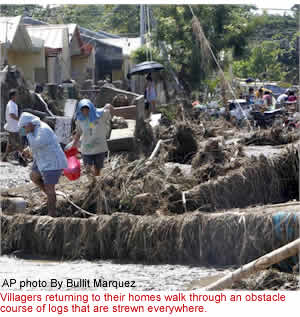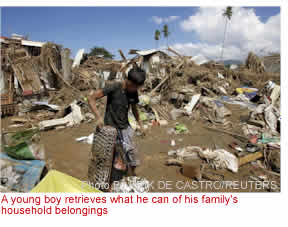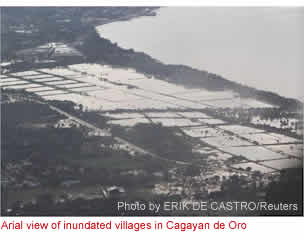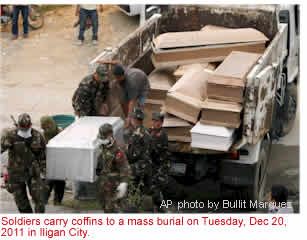The horrible outcome in lives lost and
 property destroyed is totally unacceptable to this struggling nation of close to a hundred million people. The Aquino government must to get to the bottom of this. Already, the finger-pointing has begun. PAGASA (Philippine Atmospheric, Geophysical and Astronomical Services Administration) claims their storm-warning bulletins were disregarded by local officials. Local officials on the other hand complain that they were never told how devastating typhoon Sendong (Washi) really was.
property destroyed is totally unacceptable to this struggling nation of close to a hundred million people. The Aquino government must to get to the bottom of this. Already, the finger-pointing has begun. PAGASA (Philippine Atmospheric, Geophysical and Astronomical Services Administration) claims their storm-warning bulletins were disregarded by local officials. Local officials on the other hand complain that they were never told how devastating typhoon Sendong (Washi) really was. The United States sent several urgent communiqués warning the Philippines that the approaching typhoon seemed larger and more powerful than first thought. Like the other warnings, these too seem to have been downplayed or dismissed by government officials whose job it is to inform the public of approaching weather systems and the potential havoc they bring.
government officials whose job it is to inform the public of approaching weather systems and the potential havoc they bring.
No country has a perfect record determining the severity that storm systems bring. Even the United States, with all its state-of-the-art detection equipment was caught flatfooted in the wake of hurricane Katrina that hit New Orleans in 2005. What the Americans have done is put systems in place to prevent a reoccurrence from happening. It took them years but the U.S. managed to reinforce the levees around most of Louisiana’s flood-prone parishes, they reassessed their flood protection system as well, and now have new procedures in place to prevent a repeat of their inadequate response to Katrina.
Louisiana’s flood-prone parishes, they reassessed their flood protection system as well, and now have new procedures in place to prevent a repeat of their inadequate response to Katrina.
In the end, this is what Filipinos want from their government officials. The country is being hit harder and more often by typhoons than it had been in the past. The people want an effective and well coordinated response from their government. At the same time they want to see long-range plans put in place so future generations of Filipinos can live in relative security despite nature’s wrath.
 Illegal logging appears to have magnified the devastation wrought by Sendong. Denuded forests and timber-clogged waterways amplified the catastrophe in the cities of Iligan and Cagayan de Oro.
Illegal logging appears to have magnified the devastation wrought by Sendong. Denuded forests and timber-clogged waterways amplified the catastrophe in the cities of Iligan and Cagayan de Oro.
The Philippines used to be a country blessed with an abundance of natural resources but previous generations have been lackadaisical in their stewardship of those resources. That responsibility—to preserve these gifts of nature for future generations to cherish—now falls on us. Published 12/21/2011
No comments:
Post a Comment